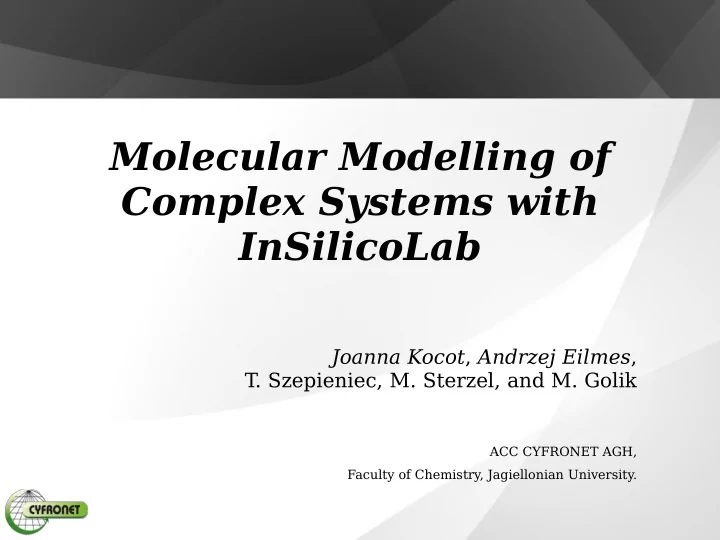

Molecular Modelling of Complex Systems with InSilicoLab Joanna Kocot , Andrzej Eilmes , T. Szepieniec, M. Sterzel, and M. Golik ACC CYFRONET AGH, Faculty of Chemistry, Jagiellonian University.
InSilicoLab: Idea • Workspace gathering all that a researcher needs for their in silico experiments › Enabling performing large-scale, long- lasting data- and computation-intensive experiments › Facilitating categorisation and description of data Enabling searches and browsing KU KDM'13, Zakopane 2
Method: Utility • Analysing the researchers work: › Ways of working › Common problems • We intend to aid in solving SPECIFIC problems • We cannot support solving ANY scientific problem › We assume it cannot be done in a universal and comprehensive way KU KDM'13, Zakopane 3
Architecture System should be optimised for problems with • common characteristics, like: › Large resource consumption Domain-specific › Repeatability – experiments conducted in Interface similar way • It is not limited to these problems Common Architecture of the whole system is generic • Integration Layer › Ensures access to large, heterogeneous Access Services, Middleware computing and storage resources › Through integration layer – built on top of Heterogeneous resource access services, middleware, etc. Resources › Presented to the user with domain/problem- specific interface KU KDM'13, Zakopane 4
InSilicoLab Architecture – Details Experiment Management Data Management Domain Analysis Preparation Specification Layer Sharing Storing Execution Managed by Reuse Viewing the user Browsing Classification Provenance Result Management Mediation Experiment Automatic Data Provenance Logic Parallelization Structure Tracking Layer translation from domain- to Execution Metadata Annotations resource-specific Engine Model Tagging language Resource Computational Metadata Access Resources Repository Layer Storage access to Resources e-infrastructures KU KDM'13, Zakopane 5
How we create/integrate new experiments Discover a pattern in the researchers work • › A joint effort of the developers and the researchers teams • Put it down as an algorithm – experiment logic • Translate into necessary scripts › Include input and results management › Allow metadata attachment Adjust interface • › Input specification › Result display › If neccessary: new data types management KU KDM'13, Zakopane 6
QC/MD Modelling • Quantum-chemical modeling of complex systems often requires: › Analysis of large molecular systems › Preparation of large sets of input files sharing common pattern › Execution of multiple computational jobs › Postprocessing of output files
QC/MD Modelling Preparation of input files Execution and monitoring of multiple computational jobs Result fetching … Reusing the result or … and analysis input data KU KDM'13, Zakopane 8
QC/MD Modelling: Sequential Approach • Sequential approach to molecules in solution: › Simulation of the solute-solvent system at the Molecular Dynamics level (classical or ab initio) › Selection of the solute with its solvation shell and performing quantum-chemical calculations (possibly at higher level of theory) to calculate solvent effect on physical properties (energies, excitation energies, chemical shifts)
What is more … Reduction Reduction of the system necessary to: Visualize the „reaction • center ” • Make the quantum- chemical calculations feasible Requires from the researcher additional effort and usually some programing skills
QC/MD Modelling: Desired Solution Desired features of a tool facilitating moecular • modelling data manipulation: › Applicability to a variety of systems › Easy and flexible definition of the selectable part of the system › Visualization at each step › Automated preparation of series of geometries and input files › Execution of QC jobs on the available infrastructure (PLGrid) › Results fetching › Parsing of the results and performing basic statistics
InSilicoLab for Chemistry KU KDM'13, Zakopane 12
Other domains Cherenkov Telescope Array (CTA) • › Project for ground based gamma-ray astronomy › Large international collaboration (25 countries) › Scientific goal is to build telescope array: 10 times more sensitive than current instruments with better energy and angular resolution with wider field of view and energy coverage with budget ~ € 190 M KU KDM'13, Zakopane 13
Other domains • MHD code created at Centre for Astronomy, Nicolaus Copernicus University in Toruń , Poland • Integration with InSilicoLab done by the Piernik developers › Only aided by the InSilicoLab team • Will be deployed as PL-Grid service • http://piernik.astri.umk.pl/ KU KDM'13, Zakopane 14
Summary The InSilicoLab portal is a solution for • researchers performing in silico experiments in many domains of science › Specific problem support, but supports many problem classes – thanks to generic system architecture Validated and running in production mode for • two domains (one beta-stage deployment) › Will be released as PL-Grid service in March (Chemistry and in December (Piernik) • Open for new collaborations KU KDM'13, Zakopane 15
Thank you! http://insilicolab.grid.cyfronet.pl insilicolab@cyfronet.pl KU KDM'13, Zakopane
Recommend
More recommend